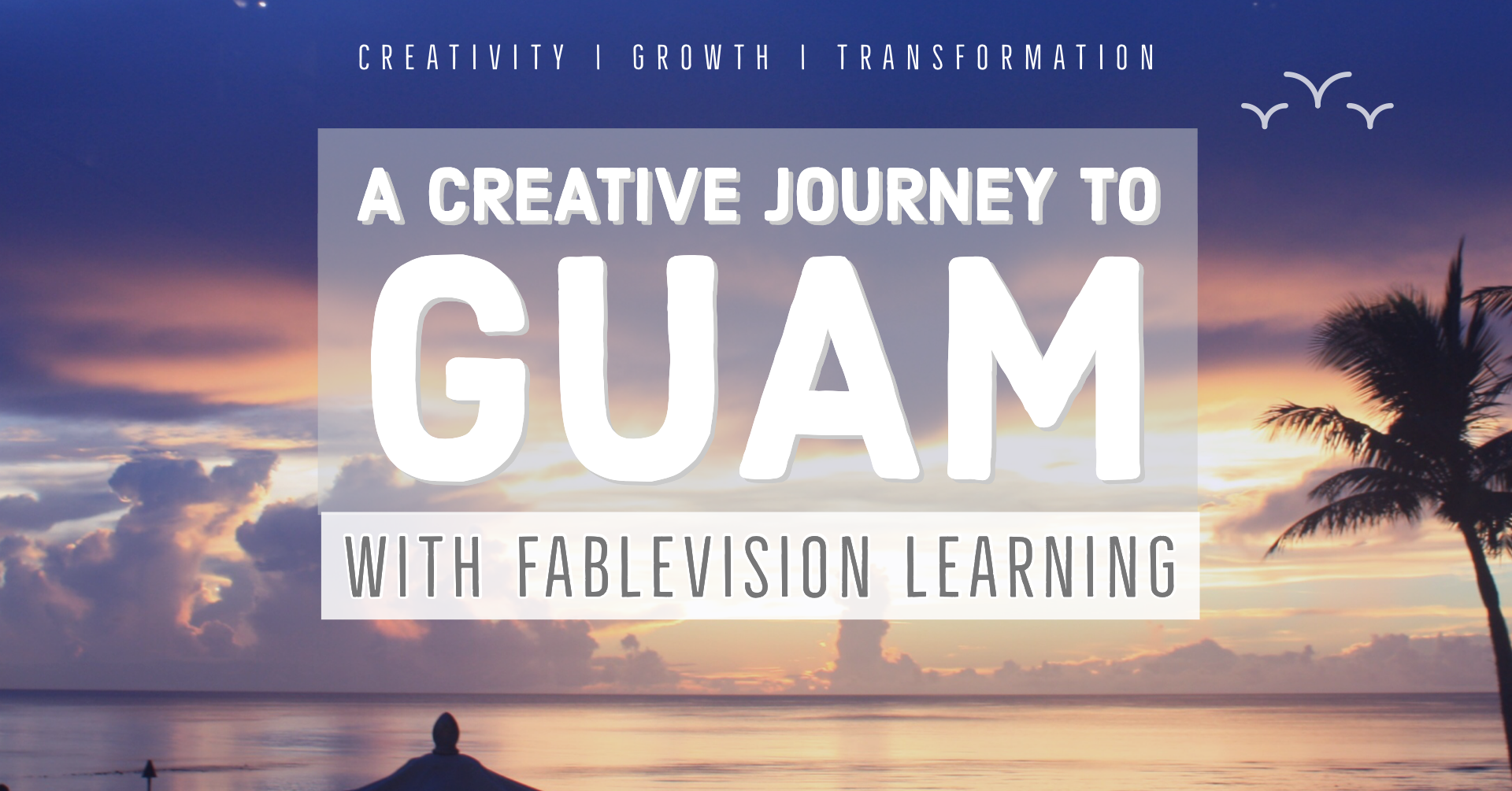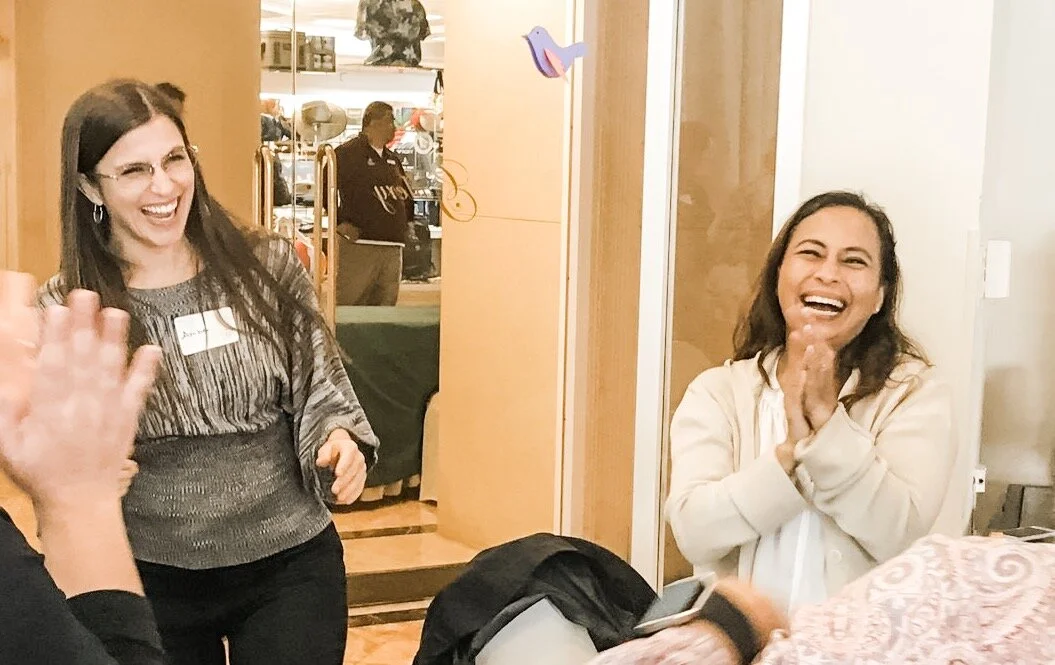A Creative Journey to Guam
This September, the team at FableVision Learning had the pleasure of spending a week exploring creativity with the GATE Gifted and Talented Educators from across the island of Guam.
This September, the team at FableVision Learning had the pleasure of spending a week exploring creativity with the GATE Gifted and Talented Educators from across the island of Guam. It was such an amazing experience!
Hafa Adai means “hello” in Guam’s native language, Chamorro
We brought them our newest workshop on creative teaching and learning, and they brought us the generous and kind Hafa Adai spirit (Hafa Adai means “hello” in Guam’s native language, Chamorro).
We were lucky enough to begin our week on International Dot Day. Our founder, New York Times best-selling author/illustrator Peter H. Reynolds, joined the room virtually, and shared his inspiring story, hopes, and appreciation.
Then, we celebrated! The teachers loved creating their own dots, and learning ways to incorporate the A in STEAM (Science, Technology, Engineering, Arts, and Math).
But, of course, art was merely the first step in our creative journey, as teachers discovered how creativity powers innovation and invention.
For the rest of the week, we dove into the science of creative thinking.
Peter H. Reynold and Paul Reynolds both joined the program virtually
We discussed a creative education framework and creative learning model. We used Peter’s picture books to practice creativity skills. We shared ideas and explored creative problem solving. We even created our own creative classroom climate checklist together, based on research.
And all throughout, we had a blast! There were games, songs, and lots and lots of laughs.
The teachers also got to explore our Creativity Maker Suite programs for students - Fab@School Maker Studio, Animation-ish, and Get Published - and ended the five-day program with a virtual chat (from 8,000 miles away!) with FableVision's CEO Paul Reynolds.
In Guam, we enjoyed games, songs, challenges, and many laughs!
By the end of the week, the teachers were full of excitement, ideas, plans, and the motivation to create bravely with their students.
Seeing these teachers alight with new ideas gave us so much excitement for the future of creative education.
All it takes are teachers who are willing to make their classrooms havens of creativity - teachers who will lead the charge in making change. We are grateful to have been a part of their journey.
We already have plans to visit Guam again soon, and can’t wait to continue to light the path of creative learning and action with other schools around the world.
To learn more about our creativity programs and training, contact info@fablevisionlearning.com
ABOUT THE AUTHOR:
Sara Smith is Creative Education Development Manager for FableVision Learning. She holds a Master of Science in creativity from the International Center for Studies in Creativity at SUNY College at Buffalo. Sara is compelled by learning and its intersection with creativity, and her vision is to develop and support creative communities that help people to grow and to nurture their passions and strengths.
On April 6, 2019, FableVision and the American University Game Lab will co-host a FREE CONFERENCE in Washington, DC, exploring Libraries, Games, and Play.
(Register and/or apply for a travel stipend by March 15, 2019!)
Learn more, and get some fun ideas and resources for custom dice + imaginative games!
On April 6, 2019, FableVision and the American University Game Lab will co-host a FREE conference in Washington, DC, exploring Libraries, Games, and Play.
FableVision/Reynolds Center co-founder and CEO Paul Reynolds will provide the closing keynote, celebrating librarians and creative educators who are providing no-tech, low-tech and high-tech tools and programs that support creativity and playful learning.
Reynolds notes that the role of librarians is especially important in light of the increasingly digital landscape that has resulted in seismic shifts in both the functions and offerings of physical libraries.
“Today’s librarians are bravely embracing technological change, as they offer exciting new portals into playful learning, and cultivate critical, future-proofing skills - such as communication, collaboration, critical thinking and creativity,” says Reynolds.
Librarians are creating innovative learning environments through the curation of digital resources and play-based learning, as well as scaffolding constructionist learning opportunities – including maker-space activities and game development.
Try It Out in Your Classroom, or at Home!
To celebrate Libraries, Games, and Play, we used Fab@School Maker Studio to create custom cardstock dice (see a tutorial for storytelling dice here). You can also experiment with other geometric forms, decks of cards, or even traditional dice sets.
For older children, two or more custom dice could be combined for:
mythical-creature drawing challenges (one of the dice shows the head, one dictates the body, and one the magical power),
improvisational role play,
rhyming, poetry, and song games,
hand-drawn board games to the theme of a child’s choosing, and so on.
Click here to download a FREE template of the printable shown on the below, which can be used with students to design games that fit into your curriculum!
When building games with students, you can keep it simple with a favorite literary theme; or, you can:
add in artistic or musical tasks,
make skip-ahead squares, reverse components, or one-one-on challenges if two players land on the same space,
add in coding-themed tasks,
cut, paste, and reconfigure on a larger board,
and tie it in to other classroom learning!
These types of games — highly customizable by age and using low-cost and accessible materials — can be used to create experiences at the intersection of playful learning and the constructionist pedagogy, which are both joyful and edifying.
What’s not to love about that?
Do you know someone who’s using games and play in libraries, or would love to learn more about how they can?
Tell them about Libraries, Games, and Play, where they can join fellow librarians, administrators, and educators. Remind them to register before March 15 - travel stipends are available, and again, the event is free!
Everyone who attends will have the opportunity to meet thought-leaders, librarians, administrators, educators, and panelists from around the country who will be discussing and documenting the latest innovations in the integration of games and play in libraries. This will be playful learning at its best!
As part of the Libraries, Games, and Play, FableVision Learning and the Reynolds Center for Teaching, Learning & Creativity will showcase a host of creative makerspace tools that offer opportunities to animate, fabricate and publish.
The team will provide a hands-on experience with Fab@School Maker Studio, the award-winning digital design & fabrication software platform for young learners.
As seen with our card stock dice game, Fab@School Maker Studio uses low-cost, easily-accessible materials to introduce the engineering design process.
FableVision Learning will also share its other signature creative learning software tools – including Animation-Ish animation tools and Get Published digital storybook academy & design studio.
Beghetto’s "Beautiful Risks": A Review
What risks have you taken lately in your classroom? Are you more likely to see risks as reckless or worthwhile?
In Beautiful Risks: Having the Courage to Teach and Learn Creatively, Dr. Ron Beghetto describes how we can look at, and think about, risk-taking in our classrooms so as to minimize the hazards and optimize the benefits.
What risks have you taken lately in your classroom? Are you more likely to see risks as reckless or worthwhile?
In Beautiful Risks: Having the Courage to Teach and Learn Creatively, Dr. Ron Beghetto describes how we can look at and think about risk-taking in our classrooms so as to minimize the hazards and optimize the benefits. Good risks are ones in which the personal benefits outweigh the negatives, bad risks are just the opposite, but it’s the beautiful risks that are the focus of this book. These are risks that have the potential to lead to creative contributions that benefit the whole classroom community.
Establishing and maintaining a creative classroom is a beautiful risk. There is no exact step-by-step process for it, and creativity inherently involves uncertainty and ambiguity. But there are substantial benefits to having a classroom in which students generate and share new thinking, and have the confidence to create. It is worth learning when and how to take the beautiful risks necessary (and when not to!).
With a firm grasp on the balance teachers must walk between pedagogical experimentation and their content standards obligations, Beghetto provides a measured approach and a gentle nudge to open up classrooms and curricula for creativity. Each chapter addresses the potential costs and benefits to the beautiful risk described in addition to providing examples to take ideas from theoretical to practical.
Prepare to embrace uncertainty, get brave enough to “go off script,” and learn to plan creative openings in your daily lessons. This book is perfect for the careful educator who wants to incorporate more creativity into his or her classroom, but is concerned about doing so responsibly. Here we share our favorite three takeaways:
We can take beautiful risks in the way we respond to students’ unusual ideas and answers in the classroom, which Beghetto calls “curricular ruptures.” Instead of just saying “No” to an incorrect answer and moving to the next student, we can take a moment to explore the student’s thinking. When we let ourselves “go off script,” we give room for students to share their creative thoughts, which increases creative confidence and potentially enriches the learning of all the students. At the same time, the author models weighing the costs and benefits so that we can learn to recognize when to take the risk and when we might not want to.
Many of us overplan in the attempt to ensure we are prepared with an appropriate lesson. The problem with overplanned lessons is that they often have the task, the process, and the outcome clearly defined, leaving little to no room for creative input from the students. Beghetto encourages taking an overplanned lesson and leaving out one or more aspects of the required components (the task, the process, or the outcome) in order to open up the lesson for creativity. Instead of trying to come up with a whole new curriculum, this is a simple way to start incorporating creativity into your teaching.
Our intentions in the decisions we make in the classroom are not always how they are perceived by our students. Within the beautiful risk of establishing a creative environment, we must be careful to address the potential hazard of our students interpreting our actions in ways that stifle their creativity. This may include our classroom management system or the way that we track students’ goals and progress. Beghetto provides the example of a data board that tracks student progress in a fun, seemingly engaging way, but because it rewards quick progress and correct answers, it actually discourages students from taking their time and coming up with novel, challenging ideas. We must check in with students and work to ensure their experience reflects the value we want to place on creative expression.
After reading this book, perhaps you’ll feel empowered to bring even more creativity into your teaching. Let us know what beautiful risks you take!
ABOUT THE AUTHOR:
Sara Smith is an educator, learner, and creativity professional. She holds a Master of Science in creativity from the International Center for Studies in Creativity at SUNY College at Buffalo. Sara is compelled by learning and its intersection with creativity, and her vision is to create and support creative communities that help people to grow and to nurture their passions and strengths.
CITATIONS:
Beautiful Risks: Having the Courage to Teach and Learn Creatively,

















